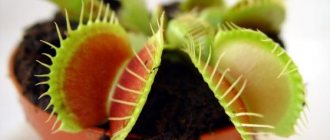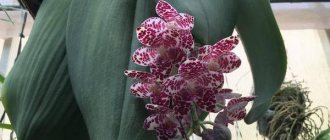Added 12/09/2013 orchids, exotics Reduce text size Increase text size Text size Print Send by mail
Determine your orchid's needs by its appearance!
Orchids have always attracted attention and excited the imagination of people.
Legends were formed about these plants, magical and medicinal properties were attributed to them, and they were passed down from generation to generation. The attractiveness of orchids can only be compared with the attractiveness of gold, and “orchid fever” appeared earlier than gold fever. Hundreds of orchid hunters went to the tropics to find and bring back exotic beauties. Now the “disease” has taken on other forms, and plants have become available to almost anyone. Butterfly orchids (phalaenopsis) can be seen in almost every flower shop; they are given as gifts or simply bought for yourself. Anyone can become the owner of an orchid!
Phalaenopsis (butterfly orchid)
It doesn’t matter how the orchid entered the house - bought out of pity at a discount, received as a gift, or you simply couldn’t pass by an unusual flower in the store, but the first delight passes, and a lot of questions about care arise after it. The first misconception immediately arises: the orchid is a capricious beauty that needs to be created in greenhouse conditions. But upon closer examination, it turns out that keeping an orchid indoors is much easier than some traditional plants.
Description
The classification of the family is basically based on the formation of the fused stamen and pistil (the so-called column), and the nature of the location of the anther and the upper part of the anther - the stigma.
Most orchid species grow in the tropical zone - and here they receive ideal conditions for development. And a characteristic feature of the distribution of orchids is precisely the diversity and originality of the flora of this family on different continents.
Of course, in temperate latitudes, orchids are less represented than in the tropics. For example, in temperate latitudes only 75 genera and 900 species are represented - only 10% of the total. In the southern temperate climate there are even fewer such plants. Only 419 species from the orchid family grow on the territory of our country.
Orchids in the temperate zone are represented by perennial terrestrial herbs that have underground (which is important for this family) rhizomes (tubers), but the tropics delight with epiphytic orchids.
What does the flower symbolize?
The orchid has been held in high esteem since ancient times. For different peoples it symbolizes:
- Love;
- beauty;
- wealth;
- sophistication;
- thoughtfulness;
- Charm.
The ancient Greeks considered this plant a symbol of masculinity . In fact, they were so convinced of the connection between Orchids and fertility that they believed that flowers with large tubers were boys and those with small tubers were girls.
The smell of vanilla accompanies flowering. Photo used as illustration. Source: Yandex.Images
The Aztecs mixed Vanilla Orchid with chocolate. They made a delicious elixir, which was endowed with magical properties that strengthened strength and spirit . And the Victorians collected these flowers to demonstrate luxury and refined taste.
Structure
The orchid family has a significant difference from all the usual flowering plants: we are talking about the fusion of filaments of stamens (there can be several of them - from one to three) with a style of gynicea. This fusion is called gynostemium or column - and, in addition to orchids, such a device is found only in Rafflesiaceae.
The orchid flowers themselves are usually collected in racemes or spikelets, much less often they are located alone (for example, lady’s slipper). Usually the flowers are three-membered, decorated with identical sepals. Of the three petals, the upper one forms the so-called lip - a kind of long outgrowth back, with nectar. And, since the downward position with this very lip is optimal for pollination, most orchids are faced with the process of resupination, or twisting.
The meaning of different shades
All Orchids symbolize love and beauty, but the colors of their buds can change the meaning of that plant. And stunning exotic flowers and equally beautiful bouquets make them an ideal gift for your loved ones
.
- Blue . A very rare shade, blue Orchid symbolizes spirituality and contemplation. This rare flower is an ideal gift for a mother or lover.
- Red . The language of red buds speaks either of passion and desire, or of strength and courage.
- Pink . Such buds signify innocence, femininity and admiration. A great gift for your beloved friend.
- White . White flowers represent reverence and humility, innocence and purity. They are an ideal amulet for mothers at the birth of a child.
- Violet . This color symbolizes admiration, respect and dignity. Such a bouquet is a great way to express your respect and admiration for a person.
- Yellow . Yellow flowers bring friendship, joy and new beginnings. A yellow bouquet of Orchids is ideal as a gift to a friend for some achievement.
- Orange . Flowers carry the energy of enthusiasm, courage and pride. Such a bouquet will help you take a responsible step towards the unknown.
- Green . Green Orchids are believed to bring happiness and good luck to the home. It is a symbol of health, life, nature and longevity.
Characteristics and Features
Among orchids, perennial herbs occupy a large distribution and dominant positions, although sometimes shrubs and even large vines are found among them.
Typically, in greenhouse conditions, tropical species of this family live to a serious age - about 70 years.
Along with autotrophic forms, saprophytes are also found in orchids. And according to the nature of the substrate, it is customary to distinguish between epiphytes - the largest group, as well as lithophytes and terrestrials, distributed mainly in temperate latitudes. Epiphytic orchids usually develop large aerial root systems that have no hairs but are characterized by a special absorptive tissue called velamen. Moreover, in some of them, the roots take over the function of photosynthesis instead of leaves.
How to care for indoor flowers?
How to care for indoor flowers at home? If you think this is difficult, then you are mistaken. Fortunately, regardless of the variety or type, caring for orchids is the same.
After purchasing a flower, it needs to find a place in the house. But first of all, the plant should be put in “quarantine”. It sounds terrible, but it is necessary. The thing is that when buying, you may not notice that the flower is sick with something or that small pests live on it that can infect healthy flowers. After purchasing, place the orchid in a place where there are no other plants and watch it for a week or two. If everything is fine with the flower, you can move it to a permanent place. It is also necessary to take care of the conditions that need to be created for the flower to function normally.
- The first thing you should pay attention to is watering, since the flowering of the plant depends on this. Watering should be moderate. Orchids like moist soil, not soggy soil, so water only when the soil begins to dry out. Irrigation using the immersion method is considered optimal. But after this it is very important to remove excess moisture from the pan. Water for irrigation must be settled or purified. In addition, it should not be cold, as the roots may get sick.
- Temperature is the second point that should also be paid attention to. During the day in the warm season, the temperature can be 17-20 degrees. At night, the readings should decrease by 4 degrees.
- Humidity plays an important role in the life of the flower and leaves. The optimal humidity percentage for orchids is 60-70%. If you have dry air in your apartment, then you can put a humidifier in the room where the orchid is located. Ventilation will also not be superfluous.
- Substrate is another important factor. In the store, the flower grows in classic soil, which is intended for orchids, but at home you can prepare the soil yourself. It may consist of expanded clay, sphagnum (moss), fine oak or pine bark and charcoal.
- Feeding. At certain stages, the flower must be fertilized. Mineral fertilizers that contain phosphorus, nitrogen and iron are well suited. This composition stimulates leaf growth and also strengthens the flower’s immune system.
- Transfer. Do not disturb the orchid too often. Usually the plant is replanted once every 2 years. But nevertheless, this must be done, because after two years there are no more useful substances left in the soil, air circulation slows down and the roots breathe poorly, which can lead to flower disease. Select a pot that will be slightly larger than the previous one. However, keep in mind that a blooming orchid cannot be replanted.
Another important factor in caring for the orchid family is reproduction. At home you can use the following methods:
- peduncle (this method is one of the simplest and is suitable for phalaenopsis orchids);
- children (for children to appear, very high temperature and humidity are required);
- It is better to propagate by cuttings in the spring (this propagation method is suitable for such orchids as “Vanda”, “Dendrobium”, “Epidendrum”);
- by dividing the bush (only an adult bush is divided, and at least three bulbs should remain on each of the divisions);
- seeds (this method is considered the most difficult, as it rarely gives good results).
Caring for orchids is not difficult, but it is important to control watering and humidity. Because of this, the orchid is considered a whimsical flower, since it is not always possible to create an optimal level of moisture, and the temperature difference that the plant requires is completely impossible in some regions of the Russian Federation. But if you try, you can achieve annual flowering.
There are incredibly many varieties of orchids; it is difficult to list all the types and varieties. But we can say with confidence that this is a unique flower, with everything special: flowers, leaves, and root system. We have also prepared a video for you that describes popular varieties of orchids, some of which we mentioned in the article. The video also draws attention to important factors that should be considered when caring for orchids.
Unusual varieties
The largest orchid flower ever recorded in size was found in the 19th century in what is now Indonesia, with petals reaching almost a meter in length.
Among the unusual species of orchids, the most fascinating with the pretentiousness and luxurious appearance of their flowers, is, for example, the monkey orchid , in the outlines of the flowers of which it is easy to see the faces of monkeys (associations with monkeys or marmosets usually come to mind). Another example is the Italian orchis, whose petal-lip shape resembles the silhouette of a human figure.
In the photo below you can see what orchids look like when grown at home:
These photographs show orchids in the wild:
Natural hybrids
In nature, most orchids are pure species, without genetic impurities. But under natural conditions, hybrids can also appear, only without human participation. This happens quite rarely, and the newly-minted hybrid is usually the “fruit of love” of 2 related species.
Example: natural hybrid
Cattleya x hardyana
appeared as a result of crossing Cattleya dowiana var. aurea x Cattleya warscewiczii.
Please note that the second word in the name is written with a small letter, as in the case of species orchids, but it is preceded by an “x” sign (a sign of hybrid origin). Also, there is no space between the x and the second word.
There are names of natural hybrids that coincide with the names of species orchids.
Example:
• Cattleya xdolosa = Cattleya Loddigesii x Cattleya walkeriana – a natural hybrid • Cattleya dolosa – an independent species of orha
Sometimes natural hybrids are written as follows: the “cross” is removed and the second word in the name is written with a capital letter so as not to confuse it with the species. But this can be misleading, since the name then takes on the appearance of an artificial hybrid (see above).
Very often, companies selling orchids don’t bother with crosses and write that way.
Example: Cattleya xdolosa becomes Cattleya Dolosa.
Download: Appendix “List of Hybrid Orchids”
Author: Irina Baltaga Updated: March 31, 2020
- All about orchids
Why doesn't the orchid bloom?
In any case, this beauty refuses to bloom due to the poor conditions of its detention. The absence of flowers can be caused by excessively dry or very humid air, the temperature of the flower below 22-25 degrees, lack of sunlight, or, on the contrary, a too “hot and sunny” window sill.
Phalaenopsis orchid flower
Why doesn't the orchid grow?
Make sure you have the proper growing conditions! Perhaps you simply flooded the pot with the plant, or you placed the container with the orchid on a window that is too sunny. Another reason is the very small container in which the flower grows and an ill-constructed substrate: the roots of the orchid need space and a lot of air. Heavy soil is absolutely not suitable for this beauty!
Orchids of the genus Dracula (Dracula simia)
Orchid family (Orchidaceae)
Life of plants: in 6 volumes. — M.: Enlightenment. Edited by A. L. Takhtadzhyan, editor-in-chief, corresponding member. USSR Academy of Sciences, prof. A.A. Fedorov. 1974.











